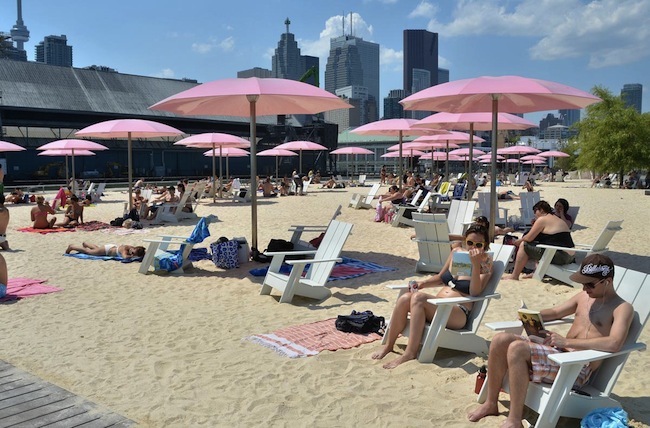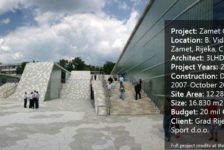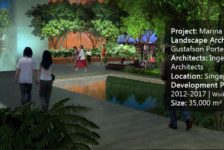Iconic, candy-coloured and hugely popular, Toronto’s award-winning Sugar Beach is making headlines again, but this time the story’s not quite so sweet.
There’s no doubt about it, Sugar Beach has certainly been a boon to the city of Toronto. Designed by Claude Cormier et Associés in 2010, the former parking lot has won multiple design awards, including the EDRA 2014 Great Places Award and an ASLA Professional Honour Award in 2012. The playful, whimsical urban beach has been a huge hit with both Torontonians and tourists alike and has flung Toronto into the international spotlight.
But the sugar-sweet image of this candied public space recently turned sour when the price-tag was revealed. Each of the thirty-six cotton candy pink umbrellas cost $11,565 and another $530,000 was spent on two huge rocks which were trucked in from the Laurentian mountains in southern Quebec. This exposé has caused public uproar among Torontonians, with many outraged at what they believe to be frivolous spending of tax-payers money.
Both the designers and Waterfront Toronto (the agency behind revitalizing the city’s waterfront) have defended the cost of Sugar Beach with the explanation that the park is a valuable investment in the future of the city.
“Our mandate is to build great parks and public spaces to revitalize the waterfront, to help make the city a better place to live,” said Andrew Hilton of Waterfront Toronto. “These parks do that, by taking what was once dead space and turning it into active, animated spaces that are going to make the area more attractive to developers and people — and that’s exactly what’s happening.”

Sugar Beach is more than just a nice space for people to enjoy, it’s also an iconic public place for the city. “Anyone just looking at the dollar cost of the umbrellas and the two large rocks is missing the point,” says Deputy Mayor Norm Kelly. “It’s the photographs of Sugar Beach that count. It’s all of that first-class investment that gets projected around the world and brands us, the city of Toronto, as world class and first class.”
RELATED STORY: EDRA Announces Six Exemplary Winners of the 2014 Great Places Awards
“You have to look at the return,” explains project landscape architect Mr. Cormier, “the ‘Jackie Kennedy pink’ umbrellas are a unique addition to the city’s urban landscape. They’re elegant. They’re soft. It has a kind of a positive mood and we need positive moods in the city, otherwise everything is so the same.”

The three dozen, 2.5 meter high structures are a sculptural, functional, exemplary contribution to the city’s public realm. Yet because they happen to take the form of a simple beach brolly, they are being ridiculed. “Hilarious. I have some lovely pink and yellow striped umbrellas – only $11,000 each and fully installed. Please call me. Limited offer – best buy now,” states one sarcastic commenter. “How wonderful – year round patio umbrellas and a couple of coloured rocks,” remarks another bitter Torontonian.
Iconic public spaces must also be durable and that’s what these umbrellas are devised to be. Designed by Toronto-based industrial designer Andrew Jones, these are not your average beach parasols. They are constructed from fibreglass and stainless steel and they also function as light standards with LED fixtures and concrete footings. Expected to last 25-30 years, they are able to withstand gale-force winds, snowstorms and rust, and are even designed to minimise opportunities for vandalism. It might have been cheaper to buy standard beach umbrellas in the short-term, but they would need to be replaced every few years and would not be nearly as striking. High quality, enduring design costs money, but is worth the investment.

The total cost for the project was $14.1 million. On the face of it, this may sound like a lot but Waterfront Toronto says the project has already created $2.6-billion in development value along the water’s edge and has catalyzed a $9.6-billion growth in private sector development.

I have to admit, upon first seeing the figures, my eyes widened. But on further reflection, my viewpoint changed. I thought: well done, Toronto! Finally, a city prepared to invest serious money in high quality public spaces. Having worked on countless projects in which the landscape has been value-engineered to within an inch of its life, it’s refreshing to see a city that recognises the true value of landscape architecture and the power it has to change perceptions and generate future investment.

Landscape architecture is often an easy target for such critical remarks about frivolous spending because the value is not always easily quantifiable. Sugar Beach is a thriving public space that has changed people’s perceptions of a previously neglected area of the city. It is bringing people together, encouraging outdoor, healthy lifestyles and – most importantly – people love it! But it’s hard to put a dollar sign against such ‘soft’ values. After all, what is the price of love?
What do you think of Sugar Beach? A sweet deal? Or a gross over-expenditure?
All images via Claude Cormier et Associés
Published in Blog











landscapeplanner
I lump this in the category of downtown streetscape improvements in smaller towns. Leading up to the recession, which started for me in Chicagoland in 2007, towns of all sizes (2,000 to 10,000 to 80,000) invested millions of dollars in streetscape improvements, often relying on municipal bonds and complex financing strategies. It wasn’t enough to simply repave the cracked sidewalks and repaint parking stripes. First towns wanted stamped concrete. Then they wanted pavers. Then they wanted pavers surrounding a logo of their town. Then they wanted pavers surrounding a logo of their town at every intersection. Then they wanted pavers surrounding a logo of their town at mid-block bulb-outs. They wanted LED lighting. Then they wanted custom bollards designed by local artists. This same pattern happened in town after town after town. The existing businesses were usually a half-empty local hardware store, a tapas bar, a 70 year old pharmacy, a tire store, and a Christian Science library, etc. When the recession hit, the tapas bar turns into a nearly empty coffee shop with gelato. The hardware store goes bust because it hasn’t been profitable since the Home Depot was built five years prior near the interstate. The tire store is still profitable. The Christian Science library is bomb proof and will survive nearly anything. In spite of the public improvements, there are no artists lofts. The only time the actual population matches the dense foot traffic in the flashy renderings is during an annual sidewalk sale. The town racks up a bunch of debt because it can’t pay down the streetscape improvements because they overcharged on their municipal “credit card” at the pedestrian mall, no pun intended. Finally, the city lays off staff to the point where fire fighters and other EMT are let go. Cities need to live within its means just like any other consumer. Now, many of these towns are paying the price. Landscape architects need to take several classes in economic development and capital improvement project budgeting to understand the long term consequences of these improvements. They also need to be suave enough to communicate this to their public sector clients and stick to their guns, no matter who is in charge or running for re-election.
Jeff Wortham
I only do residential work for middle, and upper middle class families near the Silicon valley. All of my clients need, want and appreciate value engineering. Most of that involves education of pros and cons so they can spend their money in a well informed way.
When I read about the reason for the umbrella cost it makes more sense than the price tag would imply. That said, they were guessing to some extent as to whether they would come if it was built, ala Field of Dreams. It’s great when it all works out, but how many design firms really do the research to have a strong example that could apply to them to suggest whether it really will bring in new investment or create the desired outcome?
If they do that and it works, you can sell that value. But, I see many commercial and public projects with loads of under researched and poorly thought out plans that wasted everyone’s money. There is one right by my house built in the height of the recession along a busy connector road next to a gravel mine. No one would ever sit there for the noise, terrible view of railroad tracks with old cars left there and being 2-3 miles from where anyone lives. Why would I walk that far to sit in one of 6-8 benches in that spot? Also, half the plant material is dead in one year because they didn’t understand the plants they used.This is one of our biggest failings as LAs.
These types of bad decisions reflect badly on our profession and further the list of complaints about waste. It makes people less likely to take a chance on cool projects like the one in Toronto that would benefit the greater community. We should always spend the money as if it was our family’s savings in my opinion. There is a saying;” If you don’t pay, you don’t pay attention.” Great design doesn’t stop with the great design idea, it is a complete process that considers all of the relevant variables and cost is certainly one of them.
Mark Di Lucido
I’m about ready to value engineer one of my city’s projects so this topic is on my front burner as the saying goes. By the way, seems like there should be a better descriptor for the process of VE. ‘VE’ sounds too much like another hackneyed buzz-phrase I detest, “estimate of probable cost”. How is ‘estimate of probable cost’ better or more precise than ‘cost estimate’? But I digress . . . .
Cormier’s statement, “It has a kind of a positive mood and we need positive moods in the city . . .” is interesting. Does this mean Torontonians are overly grumpy and therefore harder to design for? In my neck of the woods there would also be a few unprintable rejoinders to Cormier’s flowery explanation.
I roughly calculate the area of the project at 110,700 square feet. Dividing the total cost of $14.1 million by the area reveals a cost per square foot of $127—seems like an extraordinarily high cost for any landscape installation, especially so when you consider that Sugar Beach will probably not be used for a good part of the year as two of Cormier’s photos suggest. Apparently though, dollar values can be assigned to aesthetics and ‘soft’ values as Waterfront Toronto’s stated $2.6 billion in development value and $9.6 billion in private sector development seem to imply. If this economic stimulation does in fact result from Sugar Beach, then it’s a no-brainer—it’s an unqualified success as a created urban space and economic engine. And, almost a thousand-fold return on investment! Another question to ask is, if instead of Sugar Beach a different kind of publicly funded urban infill project was constructed would it stimulate the economy to this extent? Like say, Toronto’s SkyDome. Not that it would fit on this site, but costing $937 million in today’s dollars, the Dome would have to effect a comparable economic stimulation of $810 billion (actually quite a bit less than this as much of the cost was paid for by other government agencies and corporations)! My real point in bringing up the Dome though is that citizens don’t seem to balk at tax dollars being spent for sports but if they’re spent on art, science or public space then we’re talkin’ major frou-frou.
All that said, I’m very skeptical of almost $13 billion worth of created development value and catalyzed private sector development. That’s billion with a ‘B’. It’d be interesting to see how Waterfront Toronto calculated this. Looking at the cost another way, each Torontonian chipped in $5 to build this which doesn’t seem unreasonable if of course the city’s metro, freeways, sewer, water, police & fire protection etc., are all in good working order.
Thomas J. Johnson
$11,000 for each umbrella at “Sugar” Beach? Uh huh… How many Kilos do you get with that…?